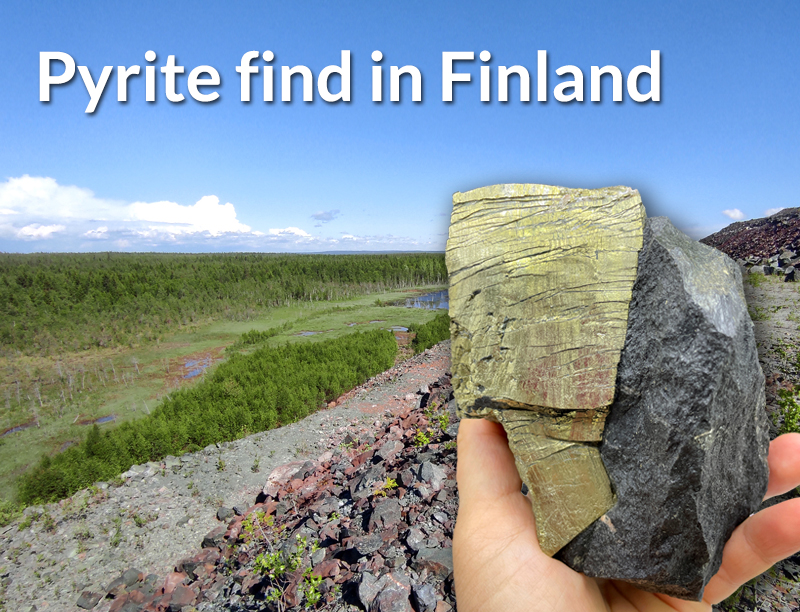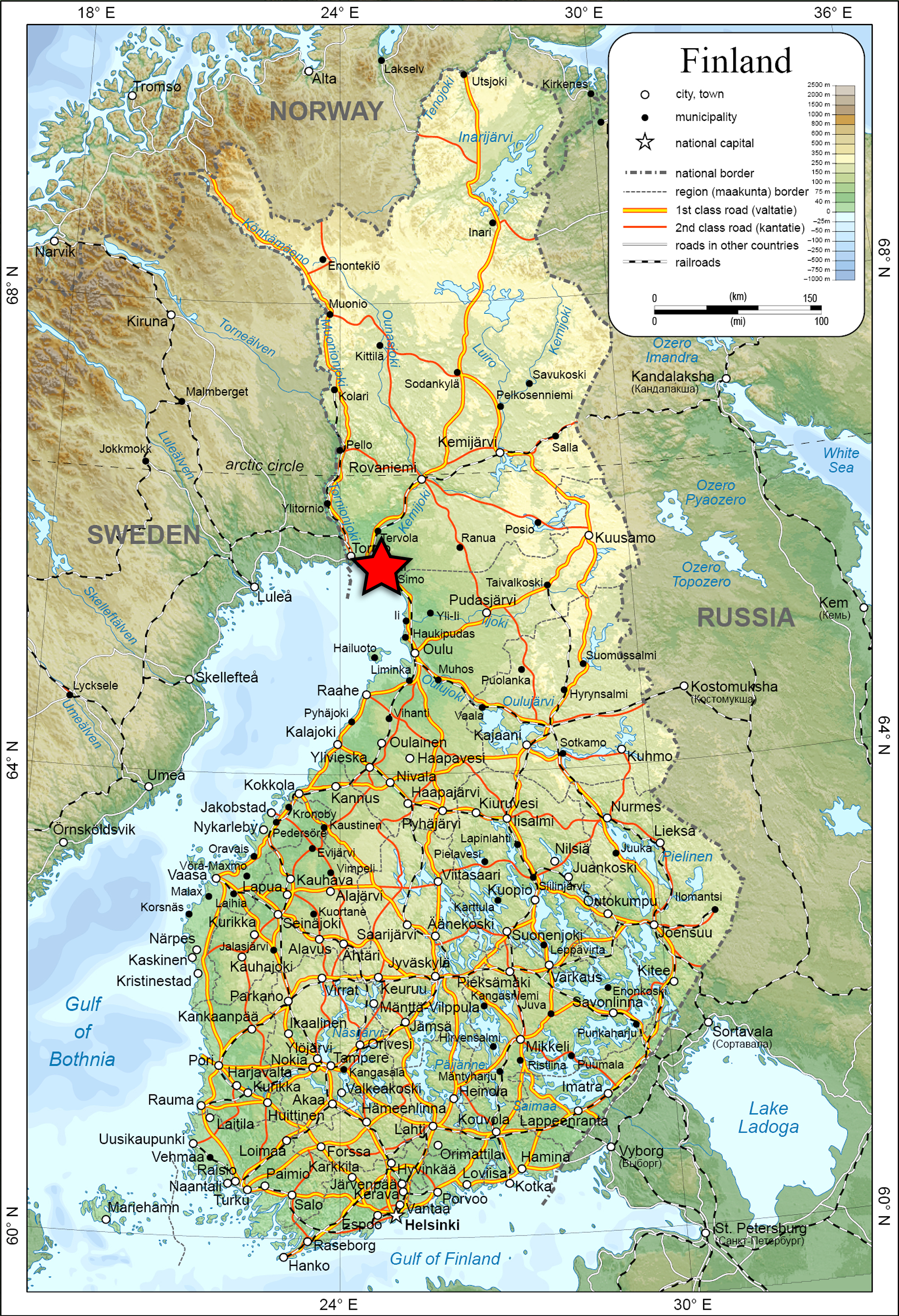
Pyrite find at the Kemi Mine, Finland
by Tomasz Praszkier
Finland is not a country typically known for mineral specimens beside of a few finds such as heliodore beryls (from Karelia Beryl Mine), andradite var. demantoids (from Outokumpu) and a few other rarities. In 2022 a small surprising find of quite good quality pyrites took place in Kemi Mine.
The biggest operating Finish mine is Kemi Mine in Lapland Province, located in the northern part of the country, at the northern end of the Gulf of Bothnia. Kemi operates in a big chromite deposit discovered in the late 1950's. In its first period of operation the ore body was mined as consequently growing open pit, which finally reached the size of 1.5 x 0,5 km and depth of 220 m! The pit was „completed" in 2005, but from the early 2000's underground mining also started. Underground part of the operation has been active till now (2023).
Kemi is a chrome mine, and the main ore is chromite. In very old (2.4 billion year-old), ultramafic layered intrusion 11 chromite orebodies are hosted. The chromite-rich horizon dips very steep – average 70 degrees northwest. The ore body continues probably to the depth of 1,000 m and ore reserves are estimated at 57.3 millions tons! The main host rock for the chromites is mafic talc-carbonates. And in this host rocks big pyrite crystals were found recentely ...
In 2022, a Polish collector – woman (who unfortunately has to stay anonymous) – in her free time, after work which she was doing in the area, was exploring the collecting potential of the giant Kemi Mine dumps. During the visit on one of the enormous dumps she found black color carbonate mafic rocks with small pyrite cubes. After researching the area on the dump it became obvious that there was more of the pyrite-rich blocks scattered around. Looked like during some short time in the mine they were excavating a zone where chromite host rock was full or pyrite crystals. Several loads of that host rock ended up in one area of the dump. When she researched area further from the original find there was nothing more of described material. So it had to be something local, probably a lense.
During her first visit she collected as many specimens as she was able to carry to the car - 1,5 km rough walk, steep down from the dump. She came back to the place a few times in 2022, taking also her boyfriend (who is a miner and geologist) to the area, to help splitting big blocks of the very hard rock and carry specimens to the car. Thanks to their efforts all blocks with bigger crystals where divided into pieces and collected. Unfortunately, because of the rock hardness and compactness, many of the pyrite crystals were broken or damaged. This is the reason why they tried to collect as big fragments of the rock as it was possible to carry, hoping that laboratory cleaning will give much better results. All together over 100 bigger specimens were collected, many containing several pyrite cubes. All of them, beside of a few pieces which they kept in their collections, were sold later to Spirifer Minerals.
Unfortunately laboratory preparation turned out to be very hard and demanding job as matrix was very solid, dense and crystals surfaces quite rough. Pyrite cubes „frozen" and "floating" in the matrix were scattered without any order so the determination where they were was impossible till the moment you start to expose them. Preparation process became very time consuming. Unfortunately most of the cubes were not perfectly formed – they were frequently distorted, with rough edges and cracks. Additionally surface of the crystals was usually not very smooth, intergrowing with matrix, what additionally made preparation more challenging as rock was not „peeling off” from the crystals. Many of the crystals were also fractured due to tectonic stress. What made specimens from this find really interesting is the unusual contrast between golden color of the pyrites and deep black matrix. Many of the specimens got several cubes on them. Also size of the crystals is impressive – the biggest ones reach up to 10 cm! Unfortunately huge crystals were almost never complete.
Concluding, pyrites from this small find in giant Kemi Mine are maybe not "word class" specimens, but they are very unusual for the country and their appearance is different than most of the known pyrites.

Map of Europe the Kemi Mine location marked.

Map of Finland the Kemi Mine location marked.

Map of Gulf of Bothnia the Kemi Mine location marked.

Satellite view to the Kemi Mine.

View to the Kemi Mine open pit.

Entrance to the underground part of the Kemi Mine.

Model of the Kemi Mine – open pit and tunnels. Red color indicates the main chromite layer.

Cross section of the Kemi Mine workings.

View from the Kemi Mine dumps to surrounding areas.

View from the Kemi Mine dumps to surrounding areas.

At the Kemi Mine dumps.

At the Kemi Mine dumps.

One of the first pyrite specimens found at the Kemi Mine dumps.

Big block with small pyrite crystals on the Kemi Mine dumps.

Block with pyrite crystals on the Kemi Mine dumps.

Block with pyrite crystals on the Kemi Mine dumps.

Block with pyrite crystals on the Kemi Mine dumps.

Block with pyrite crystals on the Kemi Mine dumps.

Block with big pyrite crystals on the Kemi Mine dumps.

Rock fragment with pyrite crystals on the Kemi Mine dumps.

Block with pyrite crystals on the Kemi Mine dumps.

Block with pyrite crystals on the Kemi Mine dumps.

Rock with pyrite crystals on the Kemi Mine dumps.

Block with enormous pyrite crystals, unfortunately incomplete ...

The same specimen, with monstrous pyrite crystal, after trimming and cleaning.

Pyrite specimen freshly collected at the Kemi Mine dumps.

Pyrite specimen freshly collected at the Kemi Mine dumps.

Block with pyrites during extraction.

Block with pyrites during extraction.

Specimens collected after breaking the big block into smaller pieces.

Freshly collected twinned pyrite specimen

Freshly collected specimen with big pyrite crystals.

Pyrite specimens after their first wash, just after they were collected at Kemi Mine dumps.

Cleaned and trimmed pyrite specimen from the Kemi Mine.

Cleaned and trimmed pyrite specimen from the Kemi Mine.

Cleaned and trimmed pyrite specimen from the Kemi Mine.

Cleaned and trimmed pyrite specimen from the Kemi Mine. Note the form of the unusual elongated crystal.

Cleaned and trimmed pyrite specimen from the Kemi Mine.

Cleaned and trimmed pyrite specimen from the Kemi Mine.

Cleaned and trimmed pyrite specimen from the Kemi Mine.

Specimen with a huge pyrite crystal from the Kemi Mine.
Thanks for the interesting article. Is the host rock carbonate-rich? If so, can pyrite be removed after acid treatment?
|
| Bob Carnein |
| 2023-06-13 00:12:34 |
Thank you ! It is not so easy unfortunately.
|
| Tomasz |
| 2023-06-13 00:30:15 |
































